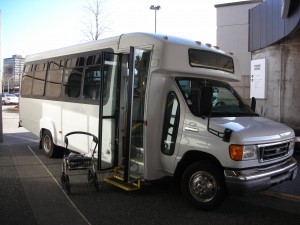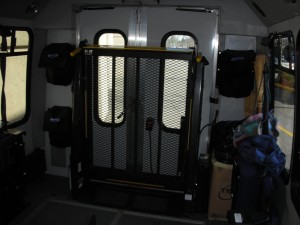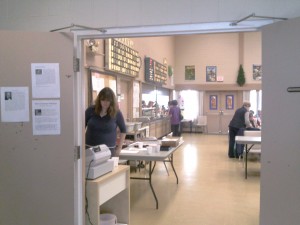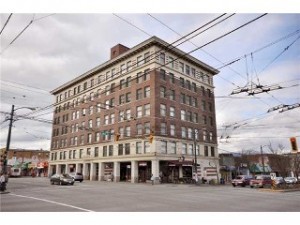Finally, after almost 2 months, we are on the verge of completing our project! Over the last two weeks, our group has been working to write, edit, and refine the final report that will be delivered to Marty from BEST. The final presentation will take place next week. This is a few days past our original tentative deadline, but the extra time was to make sure our information and presentation was professional and coherent; some of our group members were away during reading week so the work took a bit longer than expected.
Our final deliverables are, as stated earlier, a final report and a presentation. The report is 15 pages in length, and discusses the methodology used to tackle this project, maps of the routes for each seniors’ agency, and observations and impressions of how each agency’s current system is operating. Also included are details regarding the interviews we conducted with each group. The presentation will be a PowerPoint slideshow that will go over the general ideas covered in the report. A screenshot of the file is shown below.

This has been a challenging but also rewarding project. Although at times there were roadblocks, our group worked together very well and were able to resolve these issues. It is exciting to know that the information we gathered will be used by BEST in the implementation of their STAR program, which will help improve the quality of life for many seniors in the Greater Vancouver region.
Posted in Uncategorized | 2 Comments »
This week was mainly a work week, with only two meetings held where our group discussed the organization of the final report and the delegation of who would write each section. An email from Marty, the representative at BEST, gave us a rough idea of what was expected from the report. This included:
- A quick outline of our methodology
- Our impression of working with the three agencies
- A summary of information from what we gathered
- The routes we were able to map out (on maps where possible)
- Any observations about the bus services, the routes that were taken, observations from the drivers, and any other things that pertained to the project
With the exception of our methodology, each of these topics will be written for each Capilano, Silver Harbour, and West Vancouver. As a result, our group split up the work based on the people who visited each respective agency.
- Capilano – Ava and Linus
- Silver Harbour – Calvin and Michael
- West Vancouver – Andre and Lindsay
The plan is to complete the writing of each section by Saturday, where Ava and Andre will edit the report before Michael formats and puts everything together. Linus will be in contact with Marty in the next few days to organize a final date for us to present the report to BEST; this will likely be during reading week.

Posted in Uncategorized | No Comments »
At our meeting on Friday, Andre and Lindsay informed the rest of the group about their meeting with the West Vancouver Seniors’ Activity Centre. It turns out that they ended up obtaining some ridership information and also had an opportunity to ride the bus. As a result, they were able to get a substantial amount of data what we could use in our final report.
On Monday and Tuesday, several of us went to North Vancouver to ride the Silver Harbour Go Bus. On Monday, Lindsay and Michael went, while Calvin and Linus went Tuesday afternoon. Each day, we met up with John, the bus driver, and had an opportunity to talk to him about the bus program before actually going for a ride. During the rides, one person would highlight the route on a roadmap, while the other person would record the number of people who got on and off the bus at each stop. A couple pictures of the Go Bus are shown below:


Overall, the Silver Harbour bus rides were very helpful. John was very friendly, and gave us a lot of information about not only the program itself, but also his passengers. For example, he would tell us if a passenger was a regular rider or a first time user. However, there was one big challenge that we discovered through these visits. Getting a concrete map of the Go Bus route was virtually impossible, due mainly to the fact that John changes his path every day to accommodate the specific needs of his clients. This style of operation is a contrast to the other agencies, which tend to have set routes that their buses follow. For our report, we will need to discuss this, and present a map that provides a general idea of the area the Go Bus serves.
Over the last few weeks, we have obtained a substantial amount of data from the three seniors’ groups. With the end of February fast approaching, our goal for the coming week is to begin writing the final report, which will be part of our deliverables to BEST at the conclusion of this project.
Posted in Uncategorized | 1 Comment »
Due to a busy schedule for all of us, we decided to visit the Silver Harbour buses next week, on February 5 and 6. The dates were confirmed with Ms. Loverin, who informed us that we no longer needed to spend the entire day collecting data; this is great news, because there was a concern that some members of our team would be forced to miss an entire day of class for the bus rides.
On Tuesday, Ava and Linus visited the Capilano Community Services Society. The agency already has a large collection of data, including maps and ridership numbers, and their expectations are just for our group to organize this information into our final report. The main challenge with this portion of our project will be in the maps. Unlike a typical bus route, Capilano’s current system has a constantly varying route, due mainly to the fact that their target users are some of the older seniors; every week, they make phone calls to their list of riders, and alter the bus route to accommodate only the seniors in need of the transport service. For the report, we will need to analyze the data so that the map will be a good representation of the most commonly used routes for the bus.
In addition, we were finally able to arrange a meeting with West Vancouver’s Seniors’ Activity Centre. Andre and Lindsay visited the group on Thursday afternoon, and the group will discuss the needs and expectations of this agency in a meeting on Friday.
Three weeks into our project, and we remain on the tentative schedule set at the beginning of the term, which aims for a completion at the end of February. For this week, our main objectives will be:
- Ride the Silver Harbour Buses
- Look over the data given to us by Capilano
- Discuss and begin to address the needs of West Vancouver

Posted in Uncategorized | 1 Comment »
After our initial meeting with Marty, he sent us an email with the contact information of the three agencies we will be assisting. They are:
- Silver Harbour Seniors’ Activity Centre
- Capilano Community Services Society
- West Vancouver’s Seniors’ Activity Centre
Linus, as our Client Liaison, contacted each agency. He successfully reached the first two agencies on our list, but had some issues with West Vancouver due to some conflicts in time; he is currently working on that situation while we focus on the other two groups first. After talking with their representatives, it became clear that the needs of each agency were unique; for example, it seems that Capilano is willing to just provide us with maps and statistics of their bus routes for our team to put in the report, whereas Silver Harbour would like us to actually ride on their buses.
This week, we were only able to schedule a meeting with Annwen Loverin, the Executive Director of Silver Harbour. On Thursday, Calvin and Michael met with her in North Vancouver to discuss her expectations for this project. At the bottom is a picture of the inside of the Silver Harbour Seniors’ Centre. Their current system, the “Go Bus,” runs on Mondays, Tuesdays, and Wednesdays. Although the agency will provide records of routes and ridership, Ms. Loverin feels that the report would be more complete if our group spent time riding the buses and recording our own data as well. The findings will then be compared with the given records to make a more complete report. She also noted that it would be ideal for us to come at least two of the days, as the Tuesday route is quite different from the other two. This poses a challenge to our group, because our schedules make it hard to take time off during weekdays. Also, it takes over an hour by transit to travel from UBC to the Silver Harbour Seniors’ Centre.

On Friday, we will meet up to discuss which days to go and ride on the Silver Harbour buses. For next week, our main objectives are:
- Contact and arrange a meeting with the West Vancouver agency
- Go ride the buses at Silver Harbour
- Meet with the Capilano Agency (Linus has scheduled a meeting on Jan. 31)
Posted in Uncategorized | 4 Comments »
Our CSL project team consists of Andre Dratwa, Michael Elder, Lindsay Jennings, Ava Li, Calvin Lui, and Linus Yau, all second-year Civil Engineering students. Although some of us already know each other from before, Monday was the first day we officially met together as a group. During this session, team roles were assigned, and are as follows:
- Andre – Leader
- Linus – Client Liaison
- Michael – Mentor Liaison
- Lindsay – Note taker
- Calvin – Blogger
- Ava – Documents and Files Keeper
In this time, we were also introduced to our mentor, Roein Manafi. Roein is a third-year Mechanical Engineering student, and his experiences while working on a CSL project this past summer will be invaluable to our group’s success.
Our client is Better Environmentally Sound Transportation (BEST), a non-profit organization that was founded in 1991. Their focus is on promoting sustainable transportation in the Greater Vancouver Area. One of their projects at the moment is the Seniors Transportation, Access, and Resources (STAR) initiative. The purpose of this venture is to “assist urban, rural, and remote agencies in helping seniors to age in place” (STAR Canada, 2011). One of the ways they are doing this is by providing transportation services for the elderly. However, this part of the program is still in its infancy.
Our project team has been given the task of gathering and analyzing some data for three seniors’ agencies involved in STAR in the North Vancouver area. Our findings will be submitted to BEST in the form of a report and also a presentation at one of their board meetings. The expected completion date of this project is late February.
On Tuesday, we visited the BEST office, to meet with Marty Frost, the representative from the organization we will be in contact with. A picture of the office building is shown below. During this meeting, some of the details of the project were discussed. Most importantly, we were informed that we will need to visit each to the three agencies in North Vancouver sometime in the next few weeks, in order to collect data. Our main task this week will be to get in contact with these agencies.

Posted in Uncategorized | 3 Comments »
Jan 10th, 2012 by brasildude101
The purpose of this post is to gain familiarity with the function of this site blog.
→This is an offset point with the greek symbol Σ contained in it.
Posted in Uncategorized | No Comments »
Jan 7th, 2012 by Jim Sibley
You can chronicle your CSL team’s weekly accomplishments as you move toward the successful completion of your project.
Posted in Uncategorized | 1 Comment »






